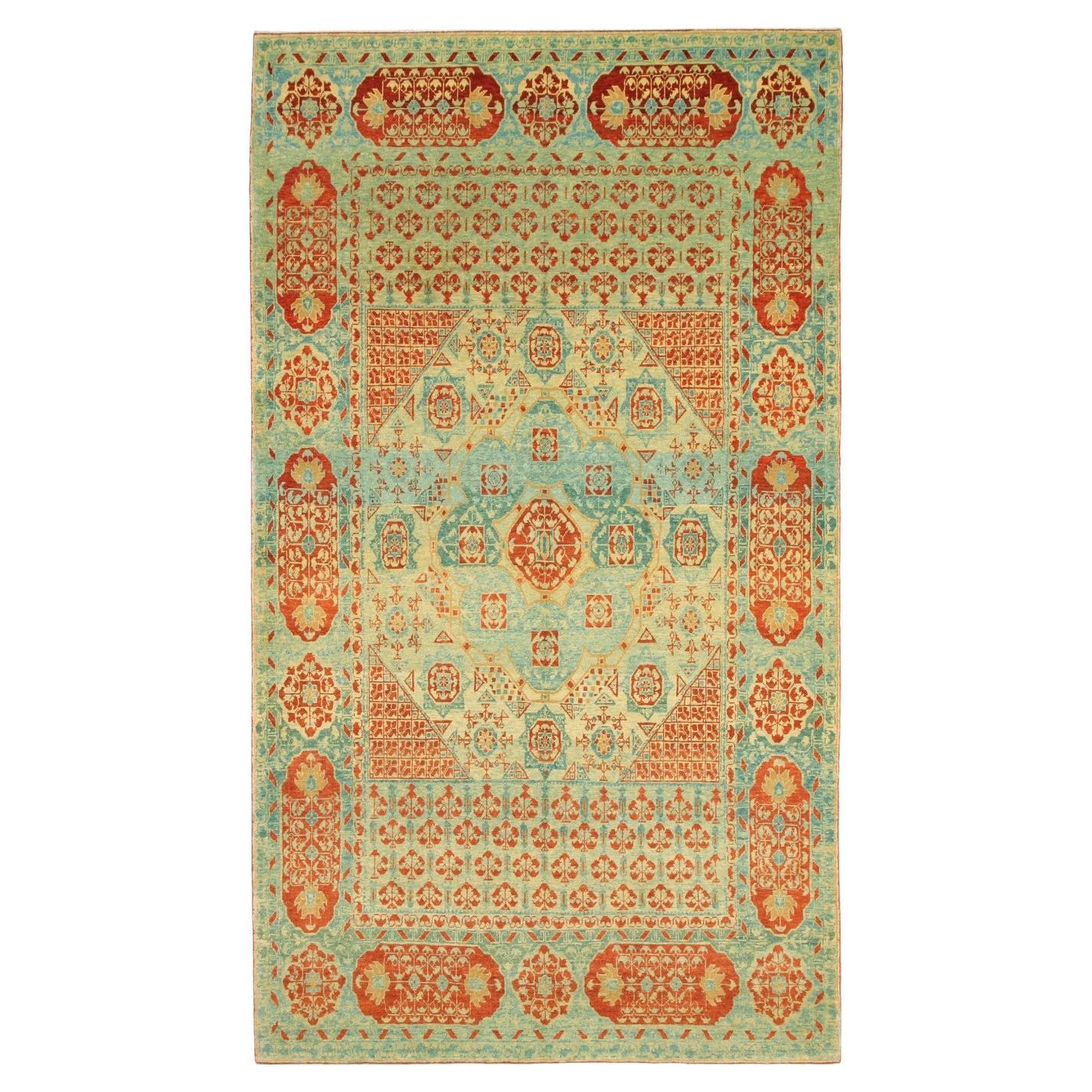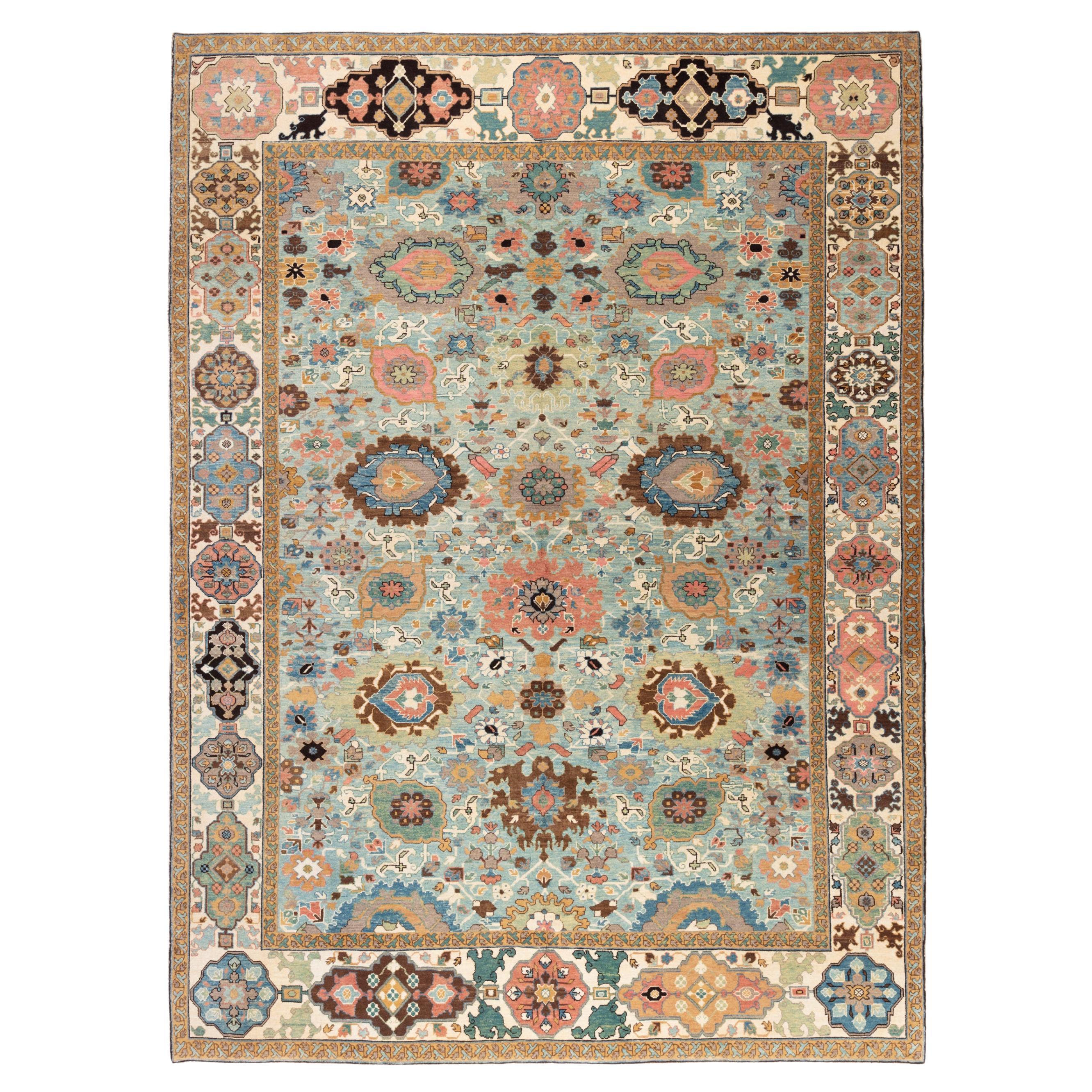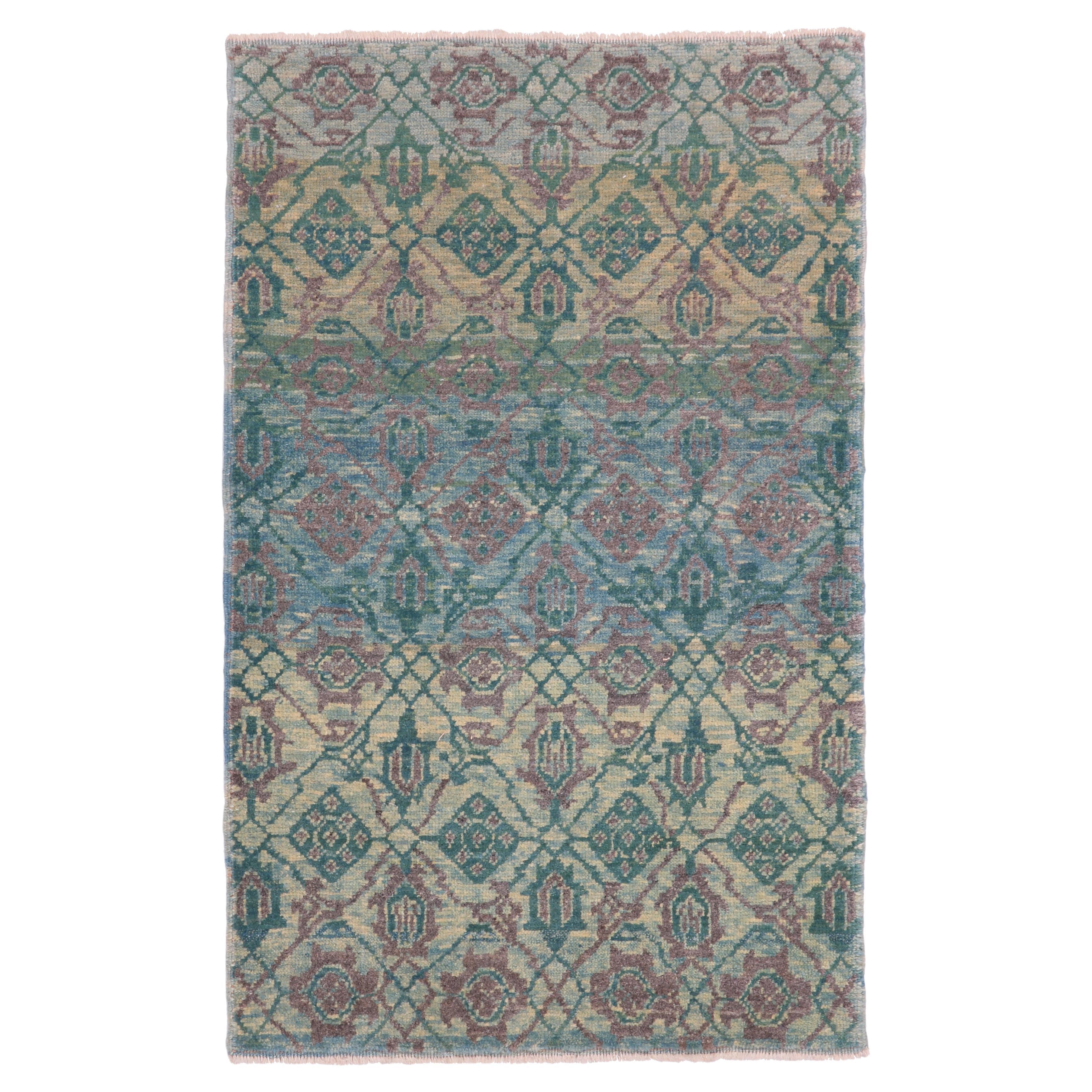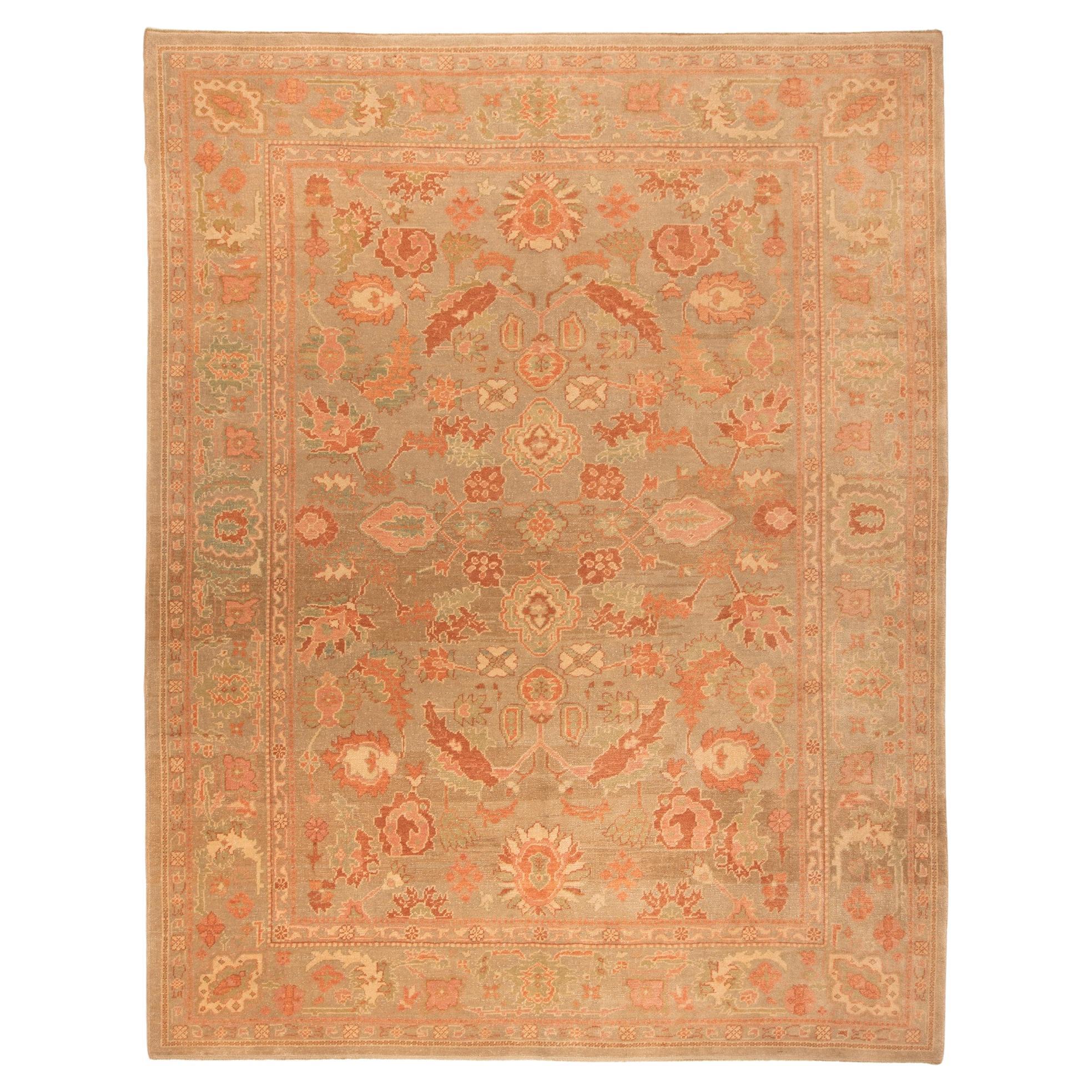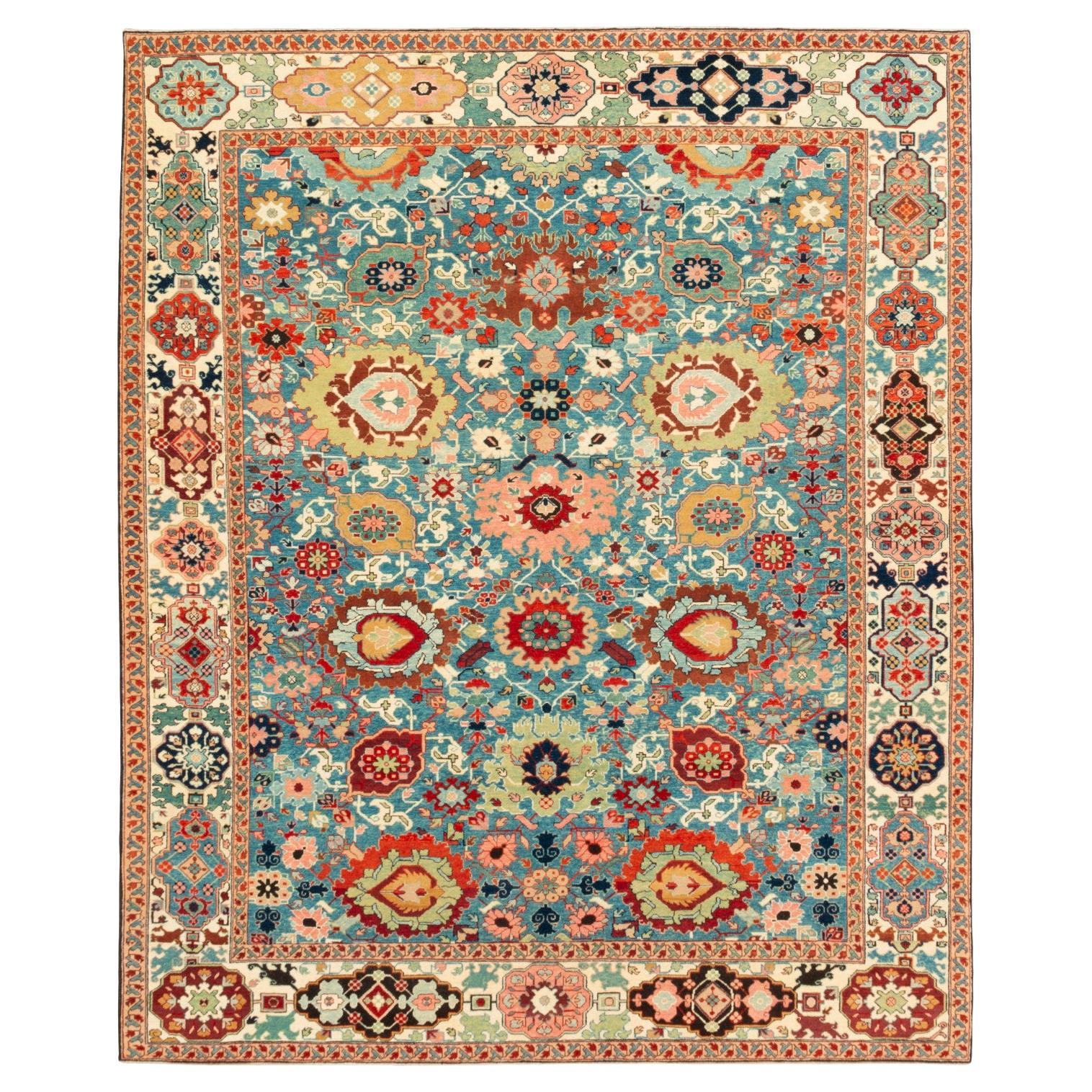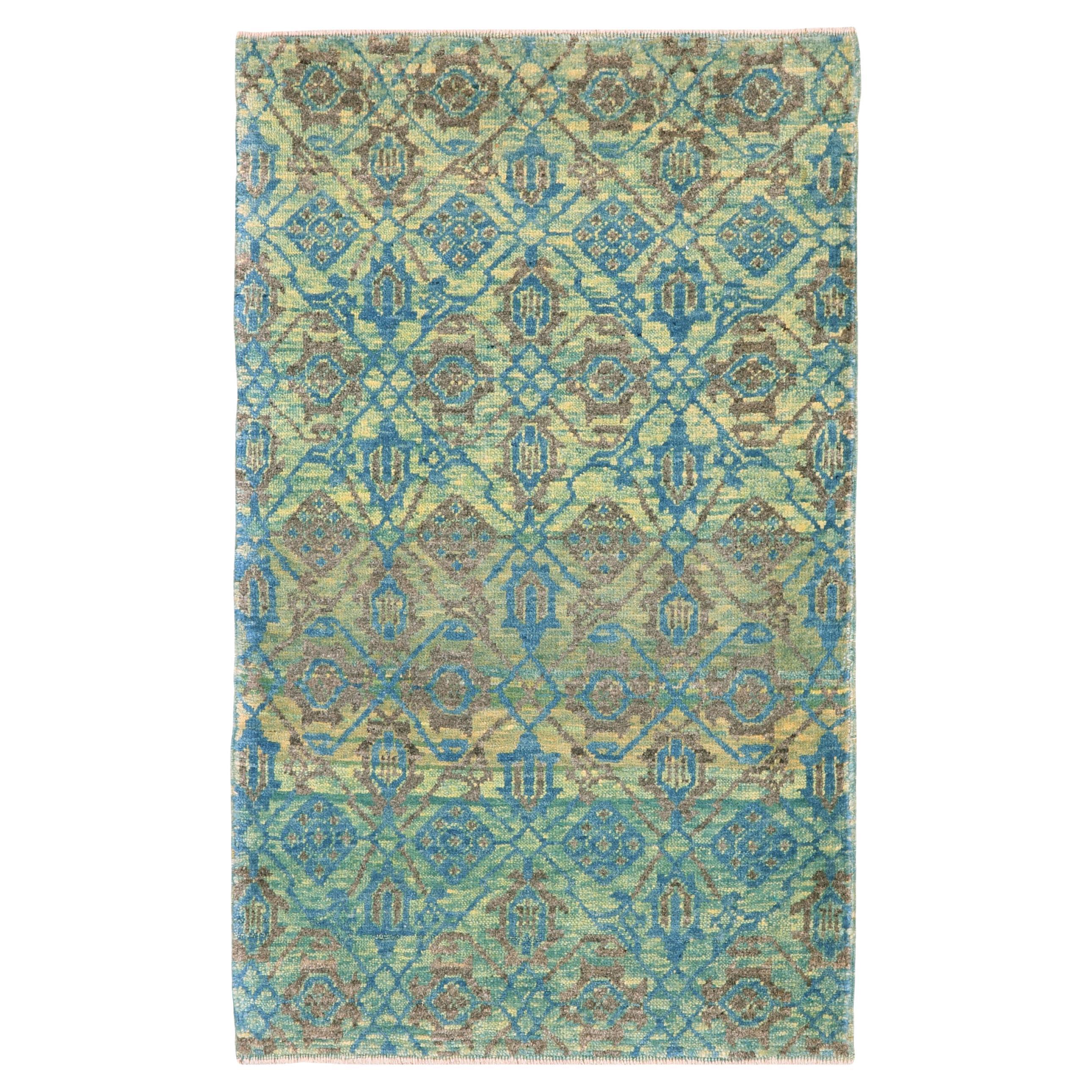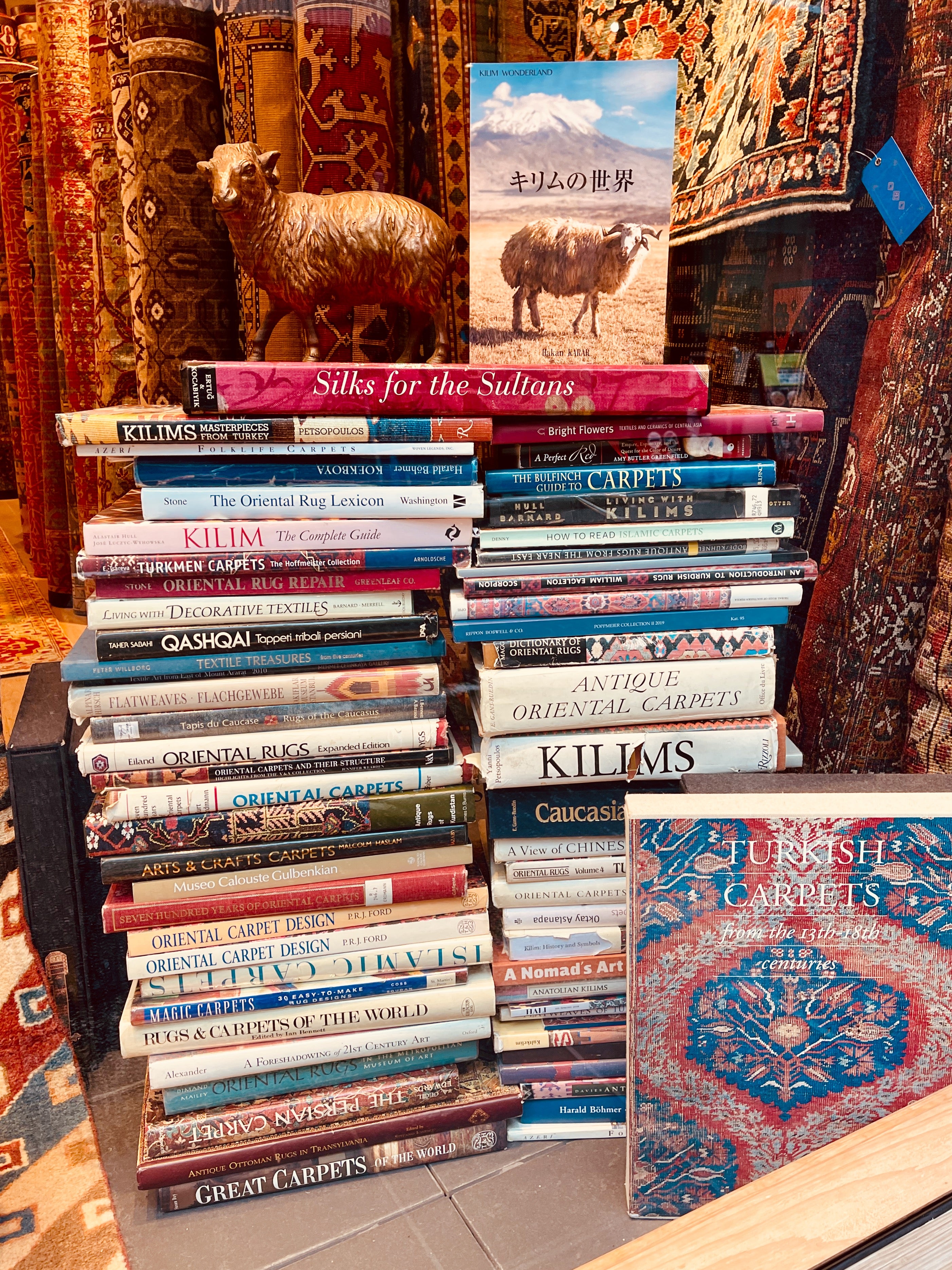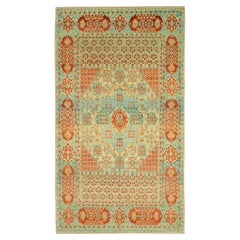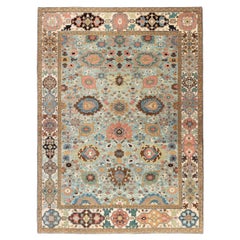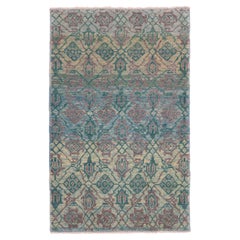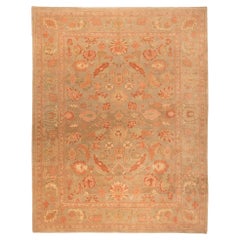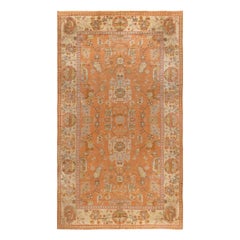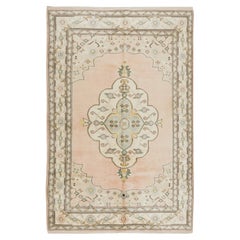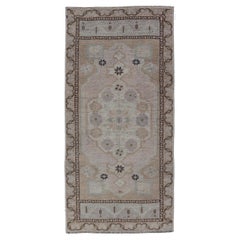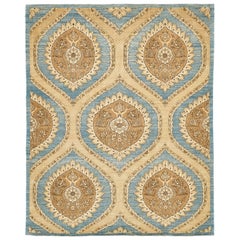Items Similar to Ararat Rugs Mamluk Carpet with Lattice Design, Antique Revival Rug Natural Dyed
Video Loading
Want more images or videos?
Request additional images or videos from the seller
1 of 6
Ararat Rugs Mamluk Carpet with Lattice Design, Antique Revival Rug Natural Dyed
$5,200
£3,945.64
€4,511.49
CA$7,262.99
A$8,075.46
CHF 4,216.56
MX$98,297.97
NOK 53,801.44
SEK 50,409.38
DKK 33,670.06
Shipping
Retrieving quote...The 1stDibs Promise:
Authenticity Guarantee,
Money-Back Guarantee,
24-Hour Cancellation
About the Item
The source of carpet comes from the Mercer Collection Sotheby’s 2000 (catalog cover). This Mamluk-Cairene carpet is known, curiously featuring some type of lattice was designed in the early 16th-century rug by Mamluk Sultane of Cairo, Egypt. This piece from the Bavarian National Museum in Munich is the most interesting, and well qualified for a court appearance with its deployment of the Persian split-leaf arabesque placed daringly at the corners of the lattice. It has a sprightly, rhythmic elegance lacking in the other examples, such as the carpets in Berlin, Textile Museum, and the Mercer piece sold at Sotheby’s in 2000. Perhaps the starting point for this design venture was an Iranian model now lost to us. Only a similar type of Textile Museum carpet features the tulip-and-pineapple border usually reserved for medallion carpets, and the lattice design forms the accompanying background, incongruously, for a standard Mamluk medallion.
Attempting to read early carpets produced in workshops in Cairo provides an entirely different set of challenges. Cairene carpets, distinguished by their limited color palette, symmetrical knotting, and unusual construction of S-spun wool (Z-spun wool being the norm almost everywhere in the Islamic world), underwent a sudden change in design sometime after the Ottoman Turks conquered the Mamluk empire in 1517. The Simonetti Carpet was probably woven after the conquest but exhibits the “old” fifteenth-century style of the Mamluks. Long and narrow, it was woven on a standard-sized Egyptian roller-beam loom, capable of producing carpets of varying lengths. It consists of five major focal areas of design in an A-B-C-B-A pattern, meaning the first and fifth and the second and fourth areas are paired, while the middle is unique. We can easily term these five focal areas medallions, but they are geometric in both layout and detail, and their style (as opposed to the actual date of the weaving) predates the carpet design revolution that gave rise to the medallion format. We can surmise that the designs and colors of Mamluk carpets, with their unusual combination of insect-derived red, blue, green, and sometimes yellow, with virtually no undyed white at all, constitute an effort to create a recognizable brand in the early modern market, especially in Europe, where Mamluk carpets such as this, with their subtle coloration, incredibly detailed design, and mosaic-like layout of small and intricately patterned geometric motifs, constituted an appealing alternative to the more coarsely woven and brightly colored carpets from Anatolia, such as Ushak medallion carpets. While the weaving of carpets in the traditional geometric Mamluk designs apparently continued well into the seventeenth century, sometime around the mid-sixteenth century, Cairene weavers began to create an entirely new kind of carpet, using their traditional Mamluk materials, technique, and coloration but reflecting the latest styles then being created at the court of the Ottoman sultans in Istanbul. The design of the rug is interpreted by our designers, and soft colors are used for this rug.
Color summary: 6 colors in total, most used 4 colors are;
Turquoise 330 (Spurge – Madder Root – Indigo – Walnut Husk)
Natural Wool Color 37 (Specially Washed)
Pale Green 439 (Chamomile – Indigo)
Sunray Color 405 (Henna)
Group: Islamic Rugs Family
Area: Mamluk
Material of Pile: Natural Dyed Hand-spun Wool
Material Warp / Weft: Wool on Wool
Structure: Symmetrical knot on depressed warp inclining to the right
Knots Density: 39x39
Production Place: Southeastern Anatolia – Adiyaman Province
Stock Location: Tokyo
Size (EU): 126 X 241cm
Size (US): 4'1" X 7'10"
Area (EU): 3m²
Area (US): 32.7ft².
- Creator:Ararat Rugs (Manufacturer)
- Dimensions:Width: 49.61 in (126 cm)Length: 94.89 in (241 cm)
- Style:Revival (In the Style Of)
- Materials and Techniques:
- Place of Origin:
- Period:
- Date of Manufacture:2022
- Production Type:New & Custom(One of a Kind)
- Estimated Production Time:Available Now
- Condition:
- Seller Location:Tokyo, JP
- Reference Number:Seller: 502701stDibs: LU8206233206552
ARARAT RUGS
We know and believe that the geography we come from, our past, and our lifestyle are the most important bond between us to carry the oriental carpet art and culture to the next generations along with our core values in our ongoing growth journey.
We are aware that the way to achieve this goal and carry this priceless art and culture to the future depends on a lot of work with all our people every day while adhering to our core values.
For us, art is meaningful in the sense that it brings together various cultures around the world. It is an honor for us that oriental carpet art and culture have been instrumental in this for centuries and that we are a part of this business.
We are tirelessly keeping an eye on auction house information around the world about carpets. New York's Metropolitan, London's Victoria & Albert Museums, and other famous art museums, as well as small specialized museums that house private collections, and books about oriental carpets to collect information on outstanding carpet designs and patterns from around the world. It's our Self-improving and Self-developing culture.
As Turkish Culture of Hospitality, the Kurdish Culture of Generosity, and as Japanese Culture of Business Punctuality; are the most important values that this multicultural background has taught and bequeathed to us. It is essential and valuable for us that you feel this feeling not only by looking at our oriental carpets but from the moment you contact us.
About the Seller
5.0
Platinum Seller
Premium sellers with a 4.7+ rating and 24-hour response times
Established in 1970
1stDibs seller since 2023
55 sales on 1stDibs
Typical response time: 3 hours
- ShippingRetrieving quote...Shipping from: Tokyo, Japan
- Return Policy
Authenticity Guarantee
In the unlikely event there’s an issue with an item’s authenticity, contact us within 1 year for a full refund. DetailsMoney-Back Guarantee
If your item is not as described, is damaged in transit, or does not arrive, contact us within 7 days for a full refund. Details24-Hour Cancellation
You have a 24-hour grace period in which to reconsider your purchase, with no questions asked.Vetted Professional Sellers
Our world-class sellers must adhere to strict standards for service and quality, maintaining the integrity of our listings.Price-Match Guarantee
If you find that a seller listed the same item for a lower price elsewhere, we’ll match it.Trusted Global Delivery
Our best-in-class carrier network provides specialized shipping options worldwide, including custom delivery.More From This Seller
View AllArarat Rugs The Simonetti Mamluk Carpet 16th C. Revival Rug, Square Natural Dyed
By Ararat Rugs
Located in Tokyo, JP
The source of carpet comes from the book How to Read - Islamic Carpets, Walter B. Denny, The Metropolitan Museum of Art, New York 2014 fig.61,62. The five-star-medallion carpet was d...
Category
21st Century and Contemporary Turkish Revival Turkish Rugs
Materials
Wool, Natural Fiber, Organic Material
Ararat Rugs Palmette Lattice Rug, 19th Century Revival Carpet, Natural Dyed
By Ararat Rugs
Located in Tokyo, JP
The source of the rug comes from the book How to Read – Islamic Carpets, Walter B. Denny, The Metropolitan Museum of Art, New York 2014 fig.82. This was an exclusive example of a pal...
Category
21st Century and Contemporary Turkish Revival Persian Rugs
Materials
Wool, Natural Fiber, Organic Material
Ararat Rugs Mamluk Wagireh Rug Lattice Pattern Revival Carpet Natural Dyed
By Ararat Rugs
Located in Tokyo, JP
This lattice pattern is composed of palmettes and leaves filling the various compartments against the imposing ground. One has the impression that it is only part of a larger scheme designed 15th-century rug from the Mamluk era, Cairo region, Eygpt. These designs have often been described as wagirehs or samplers and were said to have been used as weaver`s aids, or for demonstration purposes, made as a template or pattern for the carpet design and production of larger rugs, they are generally small pieces of the size of a scatter rug or mat.
Mamluk carpets originated in a physical environment that lacked the combination of abundant marginal grazing land and a temperate climate with cool winters that were common to most carpet-weaving areas in the Islamic world. While related to a broader tradition of Turkish weaving centered in Anatolia, far to the north, the designs of these carpets include atypical elements, such as stylized papyrus plants, that are deeply rooted in Egyptian tradition. Their unusual composition and layout probably represent an attempt to develop a distinctive product that could in effect establish a “Mamluk brand” in the lucrative European export market. The uncharacteristic color scheme—devoid of the undyed white pile and employing a limited range of three or five hues in much the same value—also suggests a conscious attempt to create a particular stylistic identity. Also virtually unique in the world of Islamic carpets is the S-spun wool. It has been argued that the tradition of clockwise wool spinning originated in Egypt because of the earlier Egyptian tradition of spinning flax into linen thread. Details of the plant’s botanical structure make it impossible to spin flax fiber in the more common counterclockwise direction utilized throughout the Middle East for wool and cotton.
Mamluk carpets with the color combinations seen in the Simonetti are now generally accepted as part of an earlier tradition that has many links to the weaving of Anatolia, Iran, and Syria. The “three-color” Mamluk carpets, well represented in the Metropolitan’s collection, represent a later development that continued well after the Ottoman conquest of Egypt in 1517. Many such carpets may have been produced well into the seventeenth century, and possibly even later. (Walter B. Denny in [Ekhtiar, Soucek, Canby, and Haidar 2011]). The design of the rug is interpreted by our designers from our Mamlouk-type rugs collection and soft colors are used for this rug.
Color summary: 3 colors in total;
Moss Green 27 (Spurge – Indigo)
Mount Olive...
Category
21st Century and Contemporary Turkish Revival Turkish Rugs
Materials
Wool, Natural Fiber, Organic Material
Ararat Rugs Oushak Palmette Lattice Rug, Turkish Revival Carpet, Natural Dyed
By Ararat Rugs
Located in Tokyo, JP
The town of Ushak, north of Denizli, is probably one of the most important and renowned carpet centers. Carpets have survived since the 16th century and can be seen in several museums. In the 17th century great quantities of Ushak carpets were made for the royal houses of Europe, often incorporating crests; many Christian churches, not only in Transylvania, were often decorated with very large pieces. According to their structure and patterning, there are several types of Ushak carpets: the star Ushak, the medallion Ushak, the ‘bird’ carpet (with a white background, the name relates to the shapes of the field motifs), and ‘Chintamani’ carpets (often with a white background and three-ball pattern, mostly in connection with cloud bands). Many great painters have ensured the survival of Ushak carpet designs by including them in their works. Two representatives of the Ushak group take their name from such renowned artists: pieces with plaited band medallions in several variations are named ‘Holbein’ carpets after Hans Holbein, the younger; ‘Lotto’ carpets refer to the painter Lorenzo Lotto...
Category
21st Century and Contemporary Turkish Oushak Turkish Rugs
Materials
Wool, Natural Fiber, Organic Material
Ararat Rugs Palmette Lattice Rug, 19th Century Revival Carpet, Natural Dyed
By Ararat Rugs
Located in Tokyo, JP
The source of the rug comes from the book How to Read – Islamic Carpets, Walter B. Denny, The Metropolitan Museum of Art, New York 2014 fig.82. This was an exclusive example of a pal...
Category
21st Century and Contemporary Turkish Revival Persian Rugs
Materials
Wool, Natural Fiber, Organic Material
Ararat Rugs Mamluk Wagireh Rug with Lattice Pattern Design Egypt Revival Carpet
By Ararat Rugs
Located in Tokyo, JP
This lattice pattern is composed of palmettes and leaves filling the various compartments against the imposing ground. One has the impression that it is only part of a larger scheme designed 15th-century rug from the Mamluk era, Cairo region, Eygpt. These designs have often been described as wagirehs or samplers and were said to have been used as weaver`s aids, or for demonstration purposes, made as a template or pattern for the carpet design and production of larger rugs, they are generally small pieces of the size of a scatter rug or mat.
Mamluk carpets originated in a physical environment that lacked the combination of abundant marginal grazing land and a temperate climate with cool winters that were common to most carpet-weaving areas in the Islamic world. While related to a broader tradition of Turkish weaving centered in Anatolia, far to the north, the designs of these carpets include atypical elements, such as stylized papyrus plants, that are deeply rooted in Egyptian tradition. Their unusual composition and layout probably represent an attempt to develop a distinctive product that could in effect establish a “Mamluk brand” in the lucrative European export market. The uncharacteristic color scheme—devoid of the undyed white pile and employing a limited range of three or five hues in much the same value—also suggests a conscious attempt to create a particular stylistic identity. Also virtually unique in the world of Islamic carpets is the S-spun wool. It has been argued that the tradition of clockwise wool spinning originated in Egypt because of the earlier Egyptian tradition of spinning flax into linen thread. Details of the plant’s botanical structure make it impossible to spin flax fiber in the more common counterclockwise direction utilized throughout the Middle East for wool and cotton.
Mamluk carpets with the color combinations seen in the Simonetti are now generally accepted as part of an earlier tradition that has many links to the weaving of Anatolia, Iran, and Syria. The “three-color” Mamluk carpets, well represented in the Metropolitan’s collection, represent a later development that continued well after the Ottoman conquest of Egypt in 1517. Many such carpets may have been produced well into the seventeenth century, and possibly even later. (Walter B. Denny in [Ekhtiar, Soucek, Canby, and Haidar 2011]). The design of the rug is interpreted by our designers from our Mamlouk-type rugs collection and soft colors are used for this rug.
Color summary: 3 colors in total;
Moss Green 27 (Spurge – Indigo)
Mount Olive...
Category
21st Century and Contemporary Turkish Revival Turkish Rugs
Materials
Wool, Natural Fiber, Organic Material
You May Also Like
Doris Leslie Blau Antique Turkish Oushak Rug
Located in New York, NY
Antique Turkish Oushak Rug
Size: 12'0" × 21'0" (365 × 640 cm)
This exquisite antique Turkish Oushak rug, handwoven around 1900, beautifully exemplifies the hallmark features of Anato...
Category
Early 20th Century Turkish Oushak Turkish Rugs
Materials
Wool
5.6x8.3 Ft Modern Hand Knotted Turkish Area Rug with Medallion Design, 100% Wool
Located in Spring Valley, NY
A hand-knotted contemporary Turkish rug.
This modern rug has even medium wool pile on wool foundation.
It is made of premium hand-spun sheep and natural dyes, ie. plant based non c...
Category
Early 2000s Turkish Modern Turkish Rugs
Materials
Wool
$990 Sale Price
40% Off
Vintage Turkish Oushak Rug with All-Over Sub-Geometric Medallion Design
Located in Atlanta, GA
Vintage Turkish Oushak Rug with All-Over Sub-Geometric Medallion Design. Keivan Woven Arts / rug EN-15901, country of origin / type: Turkey / Oushak, circa 1950
Measures: 1'9 x 3'7
Category
Mid-20th Century Turkish Oushak Turkish Rugs
Materials
Wool
Natural Dye Transitional Style Arts and Crafts Rug D5207 Bliss
By Mehraban Rugs
Located in WEST HOLLYWOOD, CA
Rug Number
12504
Size
7' 11" X 9' 11"
Design
Arts & Crafts
Collection
Traditional Re-Creations
Material
Wool
Texture
Pile Weave
Origin
Afghanistan
Age
New
Category
2010s Afghan Central Asian Rugs
Materials
Wool
17th Century Traditional French Aubusson Style Flat-Weave Rug
Located in Secaucus, NJ
Handwoven recreation of the Classic French flat-weave Aubusson rugs that have been found in the finest homes and palaces since the late 17th century. Size: 13'9'' x 22'.
Category
Antique 17th Century Chinese Aubusson Western European Rugs
Materials
Wool
Hand Knotted Vintage Turkish Wool Area Rug with Medallion Design
Located in Spring Valley, NY
A finely hand-knotted vintage Turkish carpet from 1960s featuring an elegant medallion design. The rug has even low wool pile on cotton foundation. It is heavy and lays flat on the f...
Category
Mid-20th Century Turkish Oushak Turkish Rugs
Materials
Wool, Cotton
$563 Sale Price
44% Off
More Ways To Browse
Unusual Ottoman
Egyptian Turquoise
Turquoise Ottoman
Egyptian Revival Turquoise
Czech Halabala
Long School Table
Lounge Chair Portugal
Marble Island
Mid Century Brown Leather Chair Chrome
Porcelain Dragons
Round Entry Table Carved
Round Glass Dining Tables
Spanish Round Table
Swedish Marble
Used Fine China Sets
1920 Rattan Chair
Coffee Table 36 X 36
Danish 1930s Chair
